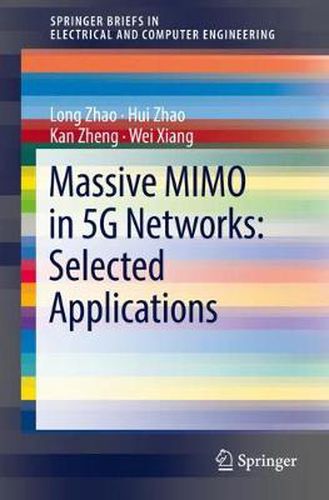Readings Newsletter
Become a Readings Member to make your shopping experience even easier.
Sign in or sign up for free!
You’re not far away from qualifying for FREE standard shipping within Australia
You’ve qualified for FREE standard shipping within Australia
The cart is loading…






This title is printed to order. This book may have been self-published. If so, we cannot guarantee the quality of the content. In the main most books will have gone through the editing process however some may not. We therefore suggest that you be aware of this before ordering this book. If in doubt check either the author or publisher’s details as we are unable to accept any returns unless they are faulty. Please contact us if you have any questions.
This SpringerBrief focuses mainly on the basic theory and applications of massive MIMO in 5G networks. The significance of massive MIMO for 5G or future communications is first briefly discussed. Then, the basic theory of massive MIMO technology is comprehensively analyzed, i.e., a variety of 5G scenarios and their improvements are described when massive MIMO is taken into account. Art physical-layer techniques and various networking techniques for interference mitigation and resource scheduling are introduced as well. This SpringerBrief also examines the selected applications of massive MIMO in 5G networks, i.e., massive MIMO-aided millimeter communications and energy transfer. The physical-layer design, multiple access control (MAC) mechanism and networking techniques are discussed for millimeter-wave communications aided by massive MIMO technology. Then, massive MIMO is covered for hybrid information and energy transfer. A downlink precoder and a uplink pilot scheme is proposed for single cell networks, and both non-cooperative and cooperative energy transfer in multi-cell are presented.
Communication researchers in the area of MIMO technology, as well as researchers and practitioners working in millimeter communications and energy transfer seeking new research topics, and topic areas with communication system design, centralized and distributed algorithms, will find this brief useful as a reference. Advanced-level students studying communication engineering will also find this book useful as a secondary text.
$9.00 standard shipping within Australia
FREE standard shipping within Australia for orders over $100.00
Express & International shipping calculated at checkout
This title is printed to order. This book may have been self-published. If so, we cannot guarantee the quality of the content. In the main most books will have gone through the editing process however some may not. We therefore suggest that you be aware of this before ordering this book. If in doubt check either the author or publisher’s details as we are unable to accept any returns unless they are faulty. Please contact us if you have any questions.
This SpringerBrief focuses mainly on the basic theory and applications of massive MIMO in 5G networks. The significance of massive MIMO for 5G or future communications is first briefly discussed. Then, the basic theory of massive MIMO technology is comprehensively analyzed, i.e., a variety of 5G scenarios and their improvements are described when massive MIMO is taken into account. Art physical-layer techniques and various networking techniques for interference mitigation and resource scheduling are introduced as well. This SpringerBrief also examines the selected applications of massive MIMO in 5G networks, i.e., massive MIMO-aided millimeter communications and energy transfer. The physical-layer design, multiple access control (MAC) mechanism and networking techniques are discussed for millimeter-wave communications aided by massive MIMO technology. Then, massive MIMO is covered for hybrid information and energy transfer. A downlink precoder and a uplink pilot scheme is proposed for single cell networks, and both non-cooperative and cooperative energy transfer in multi-cell are presented.
Communication researchers in the area of MIMO technology, as well as researchers and practitioners working in millimeter communications and energy transfer seeking new research topics, and topic areas with communication system design, centralized and distributed algorithms, will find this brief useful as a reference. Advanced-level students studying communication engineering will also find this book useful as a secondary text.